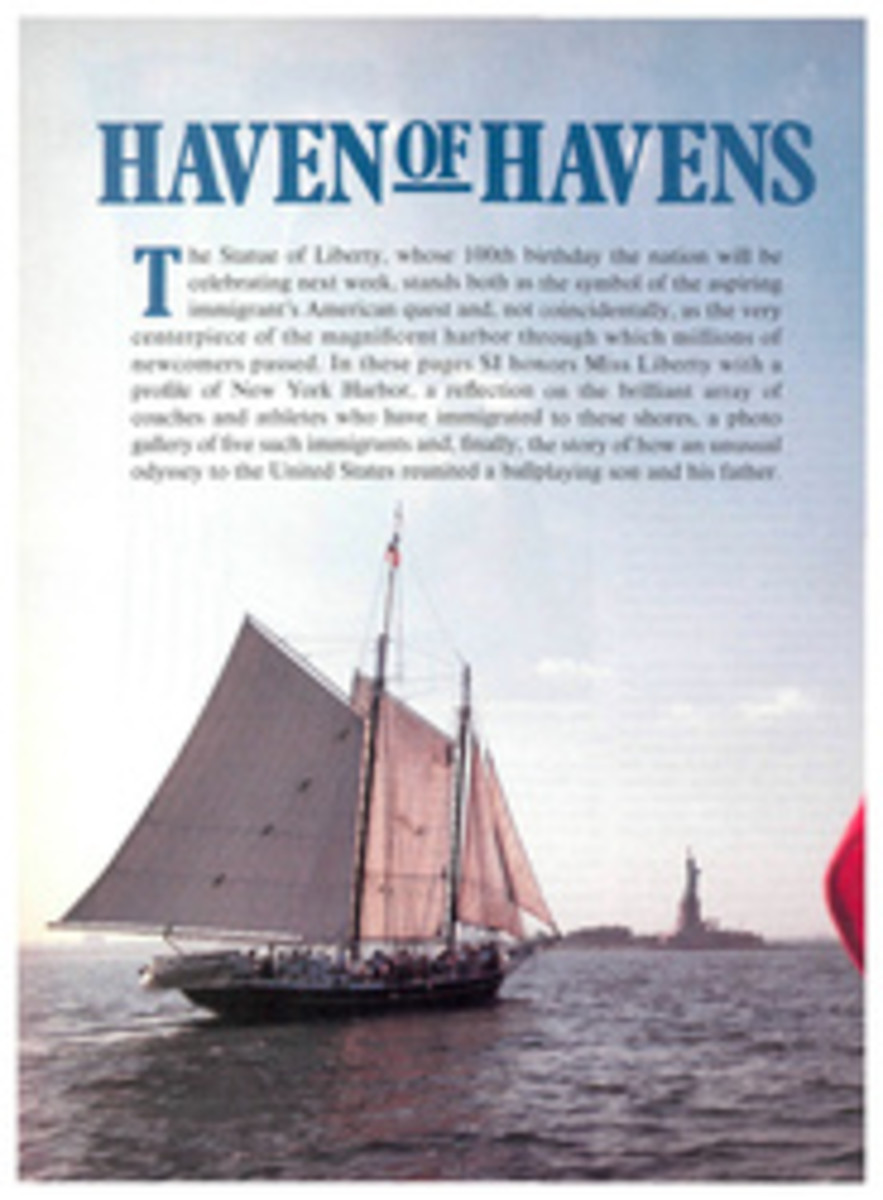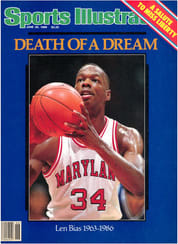
IF OUTFIELD PLAY'S THE THING, THIS CAST FROM BOSTON WAS A SMASH HIT
"A single that goes through to the outfield should score any man from second base," Connie Mack once explained. "But that doesn't go when we play Boston. At Fenway, it takes a double to bring a man home."
What Mr. Mack was referring to, what he saw from the dugout when his powerful Philadelphia A's visited the Boston Red Sox in the early part of the century, was an outfield of Duffy Lewis in left, Tris Speaker in center and Harry Hooper in right, a trio that helped the Red Sox become the best team in baseball in the years leading up to World War I. There have been many outstanding outfield combinations in the history of baseball. Certain Yankee outfields rate a mention. In the Miller Huggins era, Bob Meusel, Earle Combs and Babe Ruth won three pennants together. Joe McCarthy fielded the impressive trio of Charlie Keller, Joe DiMaggio and Tommy Henrich that played on several pennant winners in the World War II era.
But there are compelling arguments why the trio of Lewis, Speaker and Hooper should be ranked as the greatest outfield ever to play day in, day out for one team over an extended period of time. First off, they all could hit. Hooper averaged .281 over 17 seasons. Lewis batted .284 over 11 campaigns, and with power. Speaker's .344 over 22 years speaks for itself. But it was in the outfield that they redefined the defensive alignments of baseball. All three had speed and were blessed with superior arms. They threw out so many base runners trying to take an extra base or score that coaches routinely held back men who could easily have advanced. Mr. Mack's words were no exaggeration: From 1910 through 1915, the years the greatest of all outfields played together on the Red Sox, an opposing team often needed a double to safely bring home a man from second.
Speaker was the finest of the three. Only a Mays, Mantle or DiMaggio was comparable in the field. Sportswriters called Speaker "the fifth infielder." Batters and base runners could have explained why.
Speaker liked to lurk behind second base, where he could stare a batter in the eye. Little bloops and flares over second and short were easy outs for the Gray Eagle. When a ball was hit over his head, he retreated like a rocket and routinely pulled the ball in with a graceful over-the-shoulder catch.
Speaker played from 1907 to 1928, and thus his career spanned the dead and lively ball eras. On today's artificial surfaces he would be forced to position himself in deeper center. But even when the lively ball was introduced, he compensated only gradually. Few batters could drive anything over his head.
Speaker concocted a pair of dazzling set plays involving second base. In one, he would hesitate on a short line drive in his direction, appearing to lose the ball—or to be planning to take it on a bounce. The runner would take off toward third. Then the Gray Eagle would soar in at full speed, catch the ball on the run and continue to second base. Unassisted double play. John McGraw's unsuspecting Giants were victimized on that play in the seventh game of the 1912 World Series.
Speaker's other favorite involved no fewer than five Red Sox fielders. He teamed most effectively with his best friend on the team, pitcher Joe Wood. With a runner on second, Wood and his catcher would stall, as if confused over signs. The shortstop and second baseman would distract the runner, yet remain far from the bag. Speaker would charge in from short center, whereupon Wood would turn and throw. The astonished runner would find Tris waiting there to tag him out.
In rightfield, Harry Hooper was almost Speaker's equal defensively. No one was better at shoestringing a short line drive off the top of the grass—he virtually patented the rump-slide catch. Similarly, Hooper was unparalleled at racing back to the short wall in right field and pulling balls away from the outstretched fingers of Fenway spectators. A long-forgotten catch Hooper made against the Giants in the fifth inning of the final game of the 1912 Series must rank as the equal of the 1954 Willie Mays catch against Vic Wertz, the 1955 Sandy Amoros catch against Yogi Berra or the 1947 catch against DiMaggio by Al Gionfriddo. Hooper went all the way to the wall chasing a fly hit by Giants second baseman Larry Doyle. But he didn't stop at the wall—he tumbled over it, catching the ball while falling completely out of the playing field. More astounding was that he made the catch with his bare hand. It prevented the Giants from scoring enough runs to win the game in nine innings. In the 10th the Giants aided a Red Sox rally by letting an easy foul pop by Speaker drop among three fielders. Given another life, Speaker singled home the tying run before Larry Gardner wrapped up the Series for the Sox with a sacrifice fly.
In leftfield, Duffy Lewis didn't have the raw speed of Hooper and Speaker, but he had uncanny baseball intuition. Slightly chunkier than his teammates, he also had the Wall behind him and Speaker next to him. So he compensated by playing much closer to the foul line than other fielders of his era, allowing Speaker to streak into left center and poach. But in tribute to Lewis's own prowess, the raised area at the base of the leftfield wall in Fenway was known for years as Duffy's Cliff.
Lewis also was a hitter with surprising power. He was often among the American League home run or RBI leaders. A righthanded hitter, he might have hit 35 homers a year in Fenway with today's jackrabbit baseball. One of his most notable victims was Grover Cleveland Alexander, whom Lewis personally devastated with a five for eight performance in Boston's 1915 World Series victory over Philadelphia.
"That guy hits me as if I were a bush leaguer," Alexander moaned afterward.
Lewis, Speaker and Hooper arrived in Boston around the same time. Speaker came first, in 1907. When he failed to impress Red Sox management, he was dealt to the Little Rock minor league club, supposedly as compensation for the use of their spring training camp. Later, after destroying the Southern Association with a .350 batting average, Speaker was returned to the Hub for $400.
Hooper and Lewis both came to the Red Sox by way of St. Mary's College in California and the California State League. Hooper arrived in 1909, Lewis a year later. Unlike Speaker, they became regulars the moment they joined the Sox. With the opening of Fenway Park in 1912, everything jelled at once, and Boston became the powerhouse of the American League. In an era when a good outfielder might average a dozen assists a year, the Boston trio several times had upwards of 80 among them. Speaker twice had an American League-record 35 by himself even though runners and coaches quickly learned to take few liberties on the base paths.
The end of this era began with something not unusual in Red Sox history—a contract squabble between management and a star player. During the bidding war with the rival Federal League in 1914-15, Speaker's salary was increased from $9,000 to $18,000. With the demise of the upstart league after Boston had won the 1915 World Series, Red Sox owner Joe Lannin celebrated by trying to cut the Gray Eagle back to $9,000.
Speaker held out, long and bitterly. The dispute that followed ended on Opening Day 1916 when Speaker was traded to the Cleveland Indians. Boston repeated as world champions that year—Lewis and Hooper were joined in the outfield by Tilly Walker—but seeds of discontent had been sown.
Lannin sold the franchise to Harry Frazee, the Broadway producer who would eventually find fame producing No, No, Nanette! Someone ought to have said No, No to Harry. Frazee's favorite method of raising cash was to sell Red Sox stars, particularly to the Yankees. His most egregious move was dealing Babe Ruth south in 1920. Duffy Lewis went into the Navy during World War I and missed the entire 1918 season. When he returned to baseball in 1919, he was a Yank, along with Ernie Shore and Dutch Leonard, soon to be joined by Carl Mays, Waite Hoyt and Herb Pennock. Somehow, Harry Hooper missed the train and went to the White Sox instead. The Red Sox hit the second division as soon as Hooper departed in 1921; they dropped to the league basement in 1922. There the Bosox wallowed until 1934, finishing seventh once and eighth eight times over the next 12 years. Some historians maintain that the club has never fully recovered.
In the decades that followed, the great outfield of the Red Sox glory years was reunited occasionally at Old-Timers' events. Speaker passed away first, at the age of 70, in 1958. Hooper left professional baseball and served as a postmaster in California for many years before his death in 1974 at 87. Duffy Lewis, a durable baseball man, served as road secretary for the Milwaukee Braves until well into his '70s. When he died in 1979, he was 91.
Here is a footnote to the careers of Lewis, Speaker and Hooper, a reflection of their excellence: None of them ever played for a loser in the World Series. Hooper was the rightfielder on four Red Sox winners—1912, 1915, 1916 and 1918. Lewis was the leftfielder on the first three. Speaker was in center for the first two championships before being shipped to Cleveland. There he resurfaced as the player-manager for the Indians' 1920 Series victory.
By that time, of course, the Boston franchise was in irreversible decline. And the new powers of the league, the Indians and Yankees, were stocked with the elements of perhaps the greatest outfield ever.
ILLUSTRATION
STEVEN GUARNACCIA
Noel Hynd is currently writing a novel about the New York Giants baseball club.

